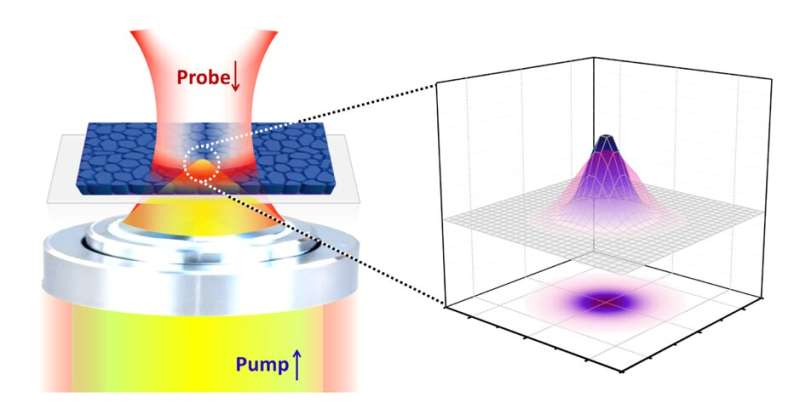December 17, 2019 feature
Study unveils new spatiotemporal dynamics of carriers in perovskite thin films

Hybrid organic or inorganic halide perovskites are a unique class of solar cell materials that break some of the material design rules that have been in place for over 30 years. For instance, they can achieve an extraordinarily high performance, despite being rich in defects and disordered on a macroscopic scale.
This disordered quality is in stark contrast with the more traditional inorganic semiconductors that are currently used to fabricate electronics. In addition, their morphology makes it far harder to quantify spatial transport parameters that are essential for optimizing the structures of devices.
The performance of semiconductor devices is fundamentally governed by charge-carrier dynamics within the materials. While many researchers have tried to gain a better understanding of these dynamics, many questions remain unanswered.
For instance, the ballistic transport of charge carriers (e.g., electrons) through these materials, also known as ballistic propagation, was so far thought to play no relevant role in enabling the functioning of photovoltaics (PVs) and light-emitting diodes. This is because this propagation is quickly disrupted after the carriers are generated, via a process known as scattering.
A team of researchers at the University of Cambridge and the University of Oxford have recently carried out a study aimed at discovering more about the charge-carrier dynamics in perovskite materials. Their study, published in Nature Physics, specifically investigated the spatiotemporal dynamics of carriers immediately after photons are absorbed by methylammonium lead iodide perovskite films.
"Interestingly, hybrid organic-inorganic halide perovskites materials also display rich ultrafast dynamics on the sub-200 fs time scale, which has remained largely unexplored till now," the researchers told Phys.org, via email. "We therefore sought a direct probe to visualize the photoinduced charge carrier transport behaviour in these materials on the femtosecond time scale coupled with nanometer spatial precision."
To investigate the spatiotemporal dynamics of carriers in methylammonium lead iodide perovskite films, the researchers used a time-resolved optical microscope with extreme temporal resolution and nanometer spatial precision. They used a highly spatially confined pump beam on the order of 200 nm to excite the material, which resulted in the generation of excited electrons only within a small area of their sample.
"By delivering a loosely focused probe beam onto the material and varying the time delay with respect to the pump beam, the spatial dynamics of the photogenerated electron distribution can be recorded," the researchers explained. "Since we are comparing the changes in the distribution over time, the spatial precision is not limited by the optical diffraction limit but by the measurement precision."
The spatial precision achieved by their optical microscope allowed the researchers to distinguish dynamics on lengthscales as small as a ten nanometers within the material. Using this time-resolved optical microscopy technique, the researchers could directly visualize the motion of electrons, even within a few tens of femtoseconds.
Their study gathered the first imaging data clearly showing the functioning of perovskite materials directly after photon absorption. They found that immediately after photons are absorbed, electrons in these materials move extremely quickly over an unprecedented distance.
"After recording the movie of photoexcited electrons, we quantified the width of the electron distribution at each snapshot and recorded the mean squared displacement," the researchers said. "This analysis provides the mobility of electrons."
The researchers observed that electrons moved at a velocity of 5 × 106 m s-1 over 150 nm, which is almost 1 percent of the speed of light over 150 nm. This enormous speed implies that in halide perovskites electrons move in a wave-like manner, as described by theories in quantum mechanics predicting wave-particle duality.
"This is a very surprising result, as it has long been assumed that the quantum mechanical behavior of electrons breaks down very quickly in solar cells and gives way 'classical' behavior," the researchers said.
The observations could have important implications for the development of new technologies, as they ultimately call for a re-evaluation of current theories on how solar cells work, both those made of perovskites and those fabricated using other inorganic semiconductors. In fact, contrary to most previous studies, these findings suggest that quantum behavior is present in most operating solar cells.
"Now that we have discovered this unprecedented transport regime, we will start looking at other materials to see if there is a universal design rule that dictates the appearance of ballistic transport," the researchers said. "If we can establish such an universal connection, it might well prove to be transformative in the way we think about designing solar cells in the future."
More information: Jooyoung Sung et al. Long-range ballistic propagation of carriers in methylammonium lead iodide perovskite thin films, Nature Physics (2019). DOI: 10.1038/s41567-019-0730-2
Journal information: Nature Physics
© 2019 Science X Network




















